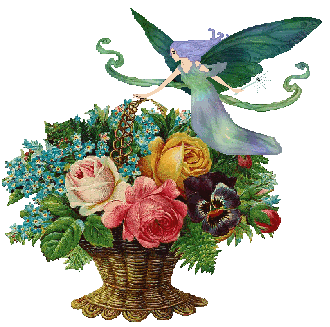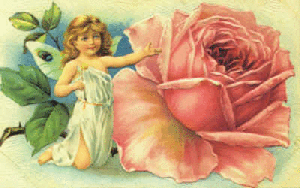
Today, people are as interested in fairies as they ever were, though most now think of them as amusing myths. However, only a few hundred years ago, belief in fairies was absolute in every strata of society. Gradually this notion dwindled among town dwellers and so-called "sophisticated" people, but country folk well into the twentieth century worried about offending the fairies. Building on a fairy path, digging into a fairy mound, forgetting to leave out cream, or omitting to pour milk on a fairy stone, all of these things and more could incur the wrath of the Little People. The crops might be ruined, the cows might sicken and the milk dry in the udder, the family might be cursed with bad luck, the baby stolen and replaced by a withered changeling, or the breadwinner paralyzed by an elf stroke.
If the fairies are treated with respect and given their due, they will help those who honor them, and may bestow great gifts on their favorites. They can teach a bard how to play music that will move an audience to tears or have them dancing with joy. They can bestow the power of healing on a mortal. The famous witch Biddy Early (d. 1873) maintained that she derived her powers from the fairies. She used a blue bottle, given to her by them, for healing. At her death it was thrown into a lake.
During the persecutions, many witches insisted that their powers were derived from fairies, not devils, as their prosecutors insisted. In the north of England, a man was accused of witchcraft and trafficking with the devil to gain a medicinal white powder. The man contended that he had received the medicine from the fairies. He would go up to the fairy mound, knock three times, and the hill would open. He would then go inside and confer with the fairies, after which they would give him a white powder with which he was able to cure those who requested his aid. He offered to take the judge and jury to the fairy hill to see for themselves. The judge was unimpressed, but the jury refused to convict him.1
In Ireland, the young girls that fairies carried off for brides would be sent back to the human world when they grew old and ugly, but with the knowledge of herbs, philters, and secret spells to give them power over men.2 In 1613, Isobel Halfdane of Perth in Scotland was carried from her bed into the fairy hills where she spent three days learning the secrets of witchcraft.
Fairies and witches were on good terms with each other, and witches were frequent visitors to the fairy hills; being accused of such visits was enough to secure a conviction as a witch. Witches were also known to grow many of the fairy plants (such as foxgloves, elder, primrose, thyme, and bluebells) in their gardens or to gather them from the wild to attract their fairy friends. At one time, even the presence of such plants in a garden was enough to warrant an accusation of witchcraft. Modern witches working in the traditional way still derive the greater part of their knowledge from the wildfolk spirits of the land.
Fairies hate idleness and are very hardworking. They will help favored humans around the house and farm, spinning, weaving, baking, churning, and building, or working as gold or silversmiths. This work is all done at night as the people sleep, as long as the house is left tidy and the hearth is swept, as fairies cannot tolerate dirt and mess. If the customary dish of cream is not left as the small reward the fairies require, then the helpful home sprite will be mortally offended and smash the crockery, wreck the spinning, and hide valuable objects. Fairies like luxury and have contempt for those who penny pinch, especially those who drain the last drop of milk from the churn or strip all the fruit from the trees, leaving none for the fairies. They punish kitchen maids who do not sweep the hearth clean and put out clean water for bathing fairy babies with pinches, cramps, and lameness, while conscientious maids are rewarded with money in their shoes and good luck.
In the past it was considered unlucky to name the fairies, or even to use the word fairy, perhaps because to do so may have summoned them, or because using a name without its owner''s permission was a threat or challenge. It was wise to call them "the Good People," "the Little People," "the Gentry," "the Mother''s Blessing," "Good Neighbors," "Wee Folk," or "the Hidden People."
The English word fairy, or faerie, is derived by way of the French fée, from the Latin fatare, meaning "to enchant." Variations on the spelling include fayerye, fairye, fayre, and faery. In England, Geoffrey Chaucer made the words fairy and elf interchangeable, though the word elf is from the Scandinavian alfar, a term that seems to mean "bright" or "shining."
There are legends of fairies all over the world, from the tiny South African Abatwa, to the Japanese Chin-Chin Kobakama, the Arabian Djinn, the Russian Deduska Domovoi, the ancient Greek nymphs, and the Albanian Zera. Around the world, fairies are mysterious creatures who live apart from the race of humankind, but who are sometimes seen in wild and lonely places.
The Victorian view of fairies was that they were all delicate, miniature, butterfly-winged creatures, but in older legends they are of human or even giant size. In medieval lore, fairies came to be divided into the aristocracy, who appeared in groups, and the common fairies, who appeared individually. The common fairies were elusive, and often the only sign of their existence was in their passing, with the bending of the flowers or the rustling of the leaves in the branches, or the patterns of Jack Frost in the windowpane. They were the guardians of individual streams, trees, forests, pools, and streams, or sometimes of private houses and particular families. The aristocrats were called Heroic or Trooping Fairies in England, and belonged to the Seelie Courts of Scotland or the Daoine Sidhe (pronounced "Theena Shee") of Ireland. The Daoine Sidhe were believed to be the diminished remnants of the Tuatha dé Danaan ("People of the Goddess Dana"), driven underground by the Celtic invaders.
Fairies are often said to live beneath the ancient burial mounds, the Hollow Hills of lore, where they feast and dance. Sometimes at night these hills sparkle with light, and if you press an ear to the hill you will hear their revels. If you sleep on the mound, fairy music will enter your soul and you will never be the same again. Earthworks are also associated with fairies; it is said that when the ancient race moved out, the fairies moved in. No tree on them should be cut down, nor should anything be built on them. If a man should be rash enough to attempt either sacrilege, the fairies will blast his eyes or give him a crooked mouth.
*~Faeries Oracle Online Reaing~* calls upon the powers of the fay to guide you and to give you a glimpse of what destiny has in store for you. All fairies can see into the future and are capable of bestowing the gift of prophecy on those they love, like the Fairy Boy of Leith, who had amazing powers of second sight, and who visited his fairy friends every Thursday at Calton Hill, near Edinburgh. The entrance to the hill was only visible to those with fairy gifts, and once inside, the boy joined in the revels, playing a drum for the fairies to dance to. Sometimes they all flew off to France or Holland for the evening. Once some men tried to keep the boy in conversation one Thursday evening, but despite all their efforts, the boy slipped away to keep his appointment with the People of the Hills.3
The fairy hills are calling, and the gateway to the Otherworld stands open. Its denizens are ready to take you by the hand and lead you into the Fairy Ring . . .
1.Durant Hotham, Life of Jacob Behmen (1654).
2. Lady Wilde, Ancient Legends, Mystic Charms and Superstitions of Ireland (London: Ward & Downey, 1887).
3.Captain George Burton, Pandaemonium (1684).
If you have any questions, please email me at faeriesoracleonline@yahoo.com Excerpt: The Fairy Ring: An Oracle of the Fairy Folk & Web Design by "Briar Rose" Copyrighted 2009
Contact: Gail Winters
